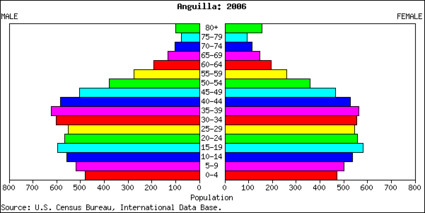Demographics of Anguilla
This article is about the demographic features of the population of Anguilla, including population density, ethnicity, education level, health of the populace, economic status, religious affiliations and other aspects of the population.
| Census population and average annual growth rate | ||
|---|---|---|
| Year | Pop. | ±% p.a. |
| 1871 | 2,800 | — |
| 1881 | 3,200 | +1.34% |
| 1891 | 3,700 | +1.46% |
| 1901 | 3,900 | +0.53% |
| 1911 | 4,100 | +0.50% |
| 1921 | 4,200 | +0.24% |
| 1946 | 5,000 | +0.70% |
| 1960 | 5,810 | +1.08% |
| 1974 | 6,519 | +0.83% |
| 1984 | 6,680 | +0.24% |
| 1992 | 8,960 | +3.74% |
| 2001 | 11,561 | +2.87% |
| 2011 | 13,452 | +1.53% |
| Source:[1][2] | ||
Population
The estimated mid-year population of 2014 is 14,500 (medium fertility scenario of The 2012 Revision of the World Population Prospects).[3]

72% of the population is Anguillian while 28% is non-Anguillian (2001 census). Of the non-Anguillian population, many are citizens of the United States, United Kingdom, St Kitts & Nevis, the Dominican Republic, Jamaica and Nigeria.
2006 and 2007 saw an influx of large numbers of Chinese, Indian, and Mexican workers, brought in as labor for major tourist developments due to the local population not being large enough to support the labor requirements.
Vital statistics[4][5][6]
| Average population (x 1000) | Live births | Deaths | Natural change | Crude birth rate (per 1000) | Crude death rate (per 1000) | Natural change (per 1000) | |
|---|---|---|---|---|---|---|---|
| 1988 | 7.6 | 160 | 21.1 | ||||
| 1989 | 8.0 | 189 | 23.7 | ||||
| 1990 | 8.3 | 159 | 19.1 | ||||
| 1991 | 8.7 | 172 | 19.8 | ||||
| 1992 | 9.0 | 141 | 15.7 | ||||
| 1993 | 9.3 | 171 | 59 | 112 | 18.5 | 6.4 | 12.1 |
| 1994 | 9.5 | 163 | 52 | 111 | 17.1 | 5.5 | 11.6 |
| 1995 | 9.8 | 167 | 54 | 113 | 17.0 | 5.5 | 11.5 |
| 1996 | 10.1 | 161 | 83 | 78 | 16.0 | 8.2 | 7.8 |
| 1997 | 10.3 | 169 | 56 | 113 | 16.4 | 5.4 | 11.0 |
| 1998 | 10.5 | 155 | 62 | 93 | 14.7 | 5.9 | 8.8 |
| 1999 | 10.8 | 176 | 58 | 118 | 16.3 | 5.4 | 10.9 |
| 2000 | 11.1 | 193 | 73 | 120 | 17.4 | 6.6 | 10.8 |
| 2001 | 11.4 | 183 | 50 | 133 | 16.1 | 4.4 | 11.7 |
| 2002 | 11.7 | 169 | 52 | 117 | 14.5 | 4.4 | 10.0 |
| 2003 | 12.0 | 139 | 65 | 74 | 11.6 | 5.4 | 6.2 |
| 2004 | 12.3 | 164 | 53 | 111 | 13.3 | 4.3 | 9.0 |
| 2005 | 12.6 | 167 | 58 | 109 | 13.2 | 4.6 | 8.6 |
| 2006 | 12.9 | 183 | 58 | 125 | 14.2 | 4.5 | 9.7 |
| 2007 | 13.1 | 148 | 70 | 78 | 11.3 | 5.3 | 5.9 |
| 2008 | 13.4 | 154 | 57 | 97 | 11.5 | 4.3 | 7.3 |
| 2009 | 13.6 | 181 | 59 | 122 | 11.3 | 3.7 | 7.6 |
| 2010 | 13.8 | 182 | 66 | 116 | 11.1 | 4.0 | 7.1 |
| 2011 | 13.037 (census) | 185 | 55 | 130 | 14.2 | 4.1 | 10.1 |
| 2012 | 13.411 | 192 | 38 | 154 | 14.3 | 2.8 | 11.5 |
| 2013 | 165 | 72 | 93 | 12.2 | 5.3 | 6.9 | |
| 2014 | 149 |
Ethnic groups
Languages
- English (official)
- The 2001 census found 11,329 were capable of carrying a conversation in English, and 101 were not. 82 of those spoke Spanish as a first language, 7 spoke Chinese.[8]
- The 2001 census found one heptalingual person, 13 pentalingual people, 35 quadralingual people, 173 trilingual people, 881 bilingual people
The total numbers of speakers of each language were:
| Language | Speakers |
|---|---|
| English | 11,329 |
| Spanish | 738 |
| French | 342 |
| Chinese | 22 |
| Italian | 42 |
| German | 59 |
| Dutch | 95 |
| Other | 128 |
Religion
Anguilla is predominantly Christian, with more than 85% identifying themselves with a denomination of Christianity. The major denomination of Christianity in Anguilla as of the 2011 Census Anglicans with 22.7%(down 236). Other large Christian denominations are:
- 19.4% Methodist(down 106)
- 8.3% Seventh-Day Adventist(up 261)
- 7.1% Baptist(up 128)
- 6.8% Roman Catholic(up 266)
Migration has also resulted in various other religions to make a presence in Anguilla, with 1.3% coming from the following Religious Groups:
| Religion | 2001 Census | 2011 Census |
|---|---|---|
| Rastafarian | 85 | 74 |
| Hinduism | 45 | 58 |
| Islam | 36 | 43 |
| Judaism | 16 | 19 |
See also
References
- ↑
- ↑
- ↑ Population Division of the Department of Economic and Social Affairs of the United Nations Secretariat, World Population Prospects: The 2012 Revision
- ↑ United nations. Demographic Yearbooks
- ↑ Anguilla Statistics Department
- ↑ http://www.caricomstats.org/Files/Databases/Demography/AI.pdf
- ↑ "Central America and Caribbean :: ANGUILLA". CIA The World Factbook.
- ↑ "Anguilla Population & Housing Census". Government of Anguilla. 9 May 2001.